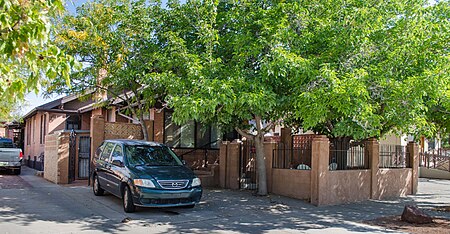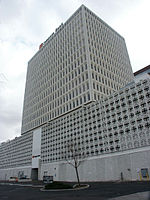A. W. Hayden House
American Craftsman architecture in New MexicoHouses completed in 1920Houses in Albuquerque, New MexicoHouses on the National Register of Historic Places in New MexicoNational Register of Historic Places in Albuquerque, New Mexico ... and 2 more
New Mexico Registered Historic Place stubsNew Mexico State Register of Cultural Properties

The A. W. Hayden House is a historic home in Albuquerque, New Mexico, United States. It was built in 1920 by A. W. Hayden, who was a local contractor and probably constructed the house himself. The property was added to the New Mexico State Register of Cultural Properties in 1979 and the National Register of Historic Places in 1980. It is a one-story, brick Craftsman style house with an unusual roofline consisting of three stepped, front-facing gables. Each gable has shingled gable ends, overhanging eaves supported by wooden brackets, and exposed rafter ends. The house also has 1-over-1 sash windows and an enclosed porch.
Excerpt from the Wikipedia article A. W. Hayden House (License: CC BY-SA 3.0, Authors, Images).A. W. Hayden House
Marble Avenue Northwest, Albuquerque Downtown Albuquerque
Geographical coordinates (GPS) Address Nearby Places Show on map
Geographical coordinates (GPS)
| Latitude | Longitude |
|---|---|
| N 35.093611111111 ° | E -106.65194444444 ° |
Address
Marble Avenue Northwest
Marble Avenue Northwest
87101 Albuquerque, Downtown Albuquerque
New Mexico, United States
Open on Google Maps










